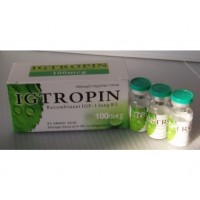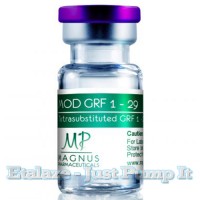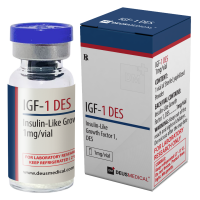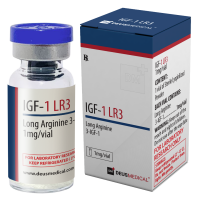IGF-1-LR3 1mg by Magnus Pharma

- Brand: Magnus Pharma
- Product Code: IGF-1
- Reward Points: 61
- Availability: In Stock
- Warehouse Europe 2
- $61.00
- Ex Tax: $61.00
- Price in reward points: 610
Tags: IGF
IGF-1 LR3 1mg by Magnus Pharma
Receptor Grade IGF-1 LR3 is a premium research reagent for use in cell growth studies, IGF receptors and IGF binding proteins and is more potent than rH IGF-1 and Media Grade IGF-1 LR3 in-vitro due to the drastic increase in biological activity (stronger affinity for the IGF receptor). This increased biological activity is what sets Receptor Grade IGF-1 LR3 apart from Media Grade (standard) IGF-1 LR3. Media grade IGF-1 LR3 is more commonly used in commercial cell culture vs mammalian and can also be used as a research reagent at an economical cost to enable studies where biological potency is of less value. To maximize results in an animal-based in-vitro cell study or production, Receptor Grade IGF-1 LR3 should be used exclusively. The supplementation of mammalian cell cultures with Long R3 IGF-1 at a much lower concentration results in more highly elevated productivity than with standard concentrations of insulin and/or standard IGF-1. IGF-1 LR3 is better able to stimulate the type 1 IGF receptor and thus induce a higher level of intracellular signaling, cell proliferation and inhibition of apoptosis.
Receptor Grade IGF-1 LR3 is more biologically active than standard IGF-1 LR3, in-vitro.
Resultantly, Receptor Grade IGF-1 LR3 will deliver superior results in comparison to standard IGF-1 LR3.
Sequence: MFPAMPLSSLFVNGPRTLCGAELVDALQFVCGDRGFYFNKPTGYGSSSRRAPQTGIV DECCFRSCDLRRLEMYCAPLKPAKSA
Molar Mass: 9,111 Da
Synonyms:Long r3 IGF-1, LR3 IGF, IGF1 LR3, Long Arg3 IGF-1
IGF-1 LR3 (Long R3 IGF-1)
IGFB Binding and The Increased Biological Activity of Long R3 IGF-1
By resisting IGFBP-binding, IGF-1 LR3 has a greater effect than IGF-1. The longer duration of action allows for smaller amounts to be used with the same effects. Some IGF-1 derivatives, such as the GPE derivative, made up of just the last three N-terminal amino acids of the IGF-1 protein, have been shown to have therapeutic effects in neurological injuries like stroke. Most studies concerning the effects of IGF-1 derivatives have been carried out in non-human animal models or cell culture studies.
The Sequence of IGF-1 LR3 and Muscle Growth
The polypeptide Long R3 Insulin-like Growth Factor-I (IGF1 LR3) is an 83 amino acid analog of IGF-I actually comprising the complete IGF-1 sequence but with the substitution of an Arginine (Arg) for the Glutamic Acid (Glu) at position 3, as well as a 13 amino acid extension peptide. This sequence change causes IGF-1 LR3 to avoid binding to proteins and allow it to have a much longer half life, around 20-30 hours. This analog of IGF-1 has been produced with the purpose of increasing the biological activity of the IGF peptide.” IGF stands for insulin-like growth factor. Among the effects the most positive are increased amino acid transport to cells, increased glucose transport, increased protein synthesis, and decreased protein degradation. When IGF is active it behaves differently in different types of tissues. In muscle cells proteins and associated cell components are stimulated. Protein synthesis is increased along with amino acid absorption. As a source of energy, IGF-1 LR3 mobilizes fat for use as energy in adipose tissue. In lean tissue, IGF-1 LR3 prevents insulin from transporting glucose across cell membranes. As a result the cells have to switch to burning off fat as a source of energy.
IGF-1 LR3 builds new muscle tissue by promoting nitrogen retention and protein synthesis. This causes the growth of muscles through both hyperplasia (which is an increase in number of muscle cells) and mitogenesis (which is the actual growth of new muscle fibers). Thus IGF-1 LR3 not only makes muscle fibers bigger, it makes more of them as well. Therefore, IGF can actually change the genetic capabilities in terms of muscle tissue and cell count. IGF increases and differentiates the number and types of cells present.
IGF-1 LR3 is a synthetic analog of the naturally existing insulin growth factor (IGF) which is a 93 amino acid residue. Modifications of the natural form occurred with the substitution of the Arg with Glu at the position 3, giving a code R3, and also an extension of a 13 amino acid at the B-terminus. Just like IGF-1, R3 has been shown to induce the development and growth of cells.
The studies on transgenic and knockout mice have shown that it can control its development and growth. It plays an important role as regulator in the G1 to S phase of the cell cycle. When applied to cardiomyocyte cultures, R3 have shown a large increase in proliferating cell nuclear antigen expression and in several cyclins involved in cell progression as well as in bromodeoxyuridien (BrdU) labeling (Kajstura et al. 1994). Other effects it has on cell lines are increased cell survival, inhibition of the apoptotic pathways, culture longevity and increased recombination of protein production (Fang et al. 1997). In another study, the application of the LR3 IGF-1 has led to an increase in the myocyte bromodeoxyuridine uptake by three to fivefold. But it has also shown that IGF-1 LR3 actions have been blocked by the ERK and P13K labeling which completely abolished the BrdU uptake. Furthermore, ut has been shown that in mycocytes, IGF-1 R3 stimulates the cardiomyocyte division in vivo (Sundgren et al. 2003). It has also been suggested that IGF-1-Long 3R is more potent than the IGF-1 because of its low binding capacity with all known IGF binding proteins (Tomas et al. 1995). In another investigation, feeding of LR3-IGF-1 in different amounts to investigate the effects on somatotropic axis (plasma levels of IGF-1 and 2, IGFBPs) was done. They have reported that plasma Long-R3 increased when administered subcutaneously but with no such behavior when administered orally. Furthermore, LR3 lowered the levels of native IGF-1 in rbGH-injected in calves, but L-R3 increased the amounts of IGF-II concentrations when administered with L-R3 subcutaneously. The parenteral administration of the Long R3 IGF-1 decreased the growth hormone concentration but did not affect the secretory system. It was also reported that the somatotrophic acis is basically functioning in neonatal calves and can be influenced by nutrition, growth hormone and Long-R3-IGF-1 (IGF1-LR3). (Hammon and Blum 1997).
The Half-Life of IGF-1 LR3 and its Effects of IGF-1
It has a considerably longer half-life than other form, nearly 20-30 hours. When IGF-1 LR3 is active, has multiple effects on tissues in muscle cells. It plays a essential role in muscle renewal. IGF-1 LR3 encourages both increase as well distinction of stem cells. IGF-1 LR3 increases satellite cell activity, muscle DNA, muscle protein content, muscle weight and muscle cross sectional area. The importance of IGF-1 LR3 lies in the fact that all of its obvious effects work to induce muscle growth. These effects are enhanced when combined with weight training.
Protein creation is better along with amino acid absorption as a source of energy. It enhances use of fat as energy. In lean tissue, IGF-1 LR3 prevents insulin form carrying glucose across cell membranes, as a result, the cells have to change to burning off fat as a source of energy. IGF-1 LR3 also mimics insulin in the human body.
Perhaps the most remarkable also strong influence it has on the human body is its ability to cause hyperplasia, which is an definite splitting of cells. Hypertrophy is what ensues during weight training; it is an increase in the size of muscle cells. Adult humans have a fixed number of muscle cells, that can become larger with training, however the number of muscle sells does not increase. But, with this preparation use you are able to induce hyperplasia which actually increases the number of muscle cells present in the muscle. Research studies show that with weight training the new cells develop faster and become stronger and more dense.
IGF-1 LR3 used in CLINICAL RESEARCH
IGF-1 LR3 plays an important part in childhood growth and continues to have results in adults. It is made in the human body and is at ideal levels during puberty. In most studies, the maximum active length for research studies IGF-1 LR3 is 50 days on also 20-40 days off. The most common range used during clinical research is typically between 20mcg to 120mcg per day.
During puberty, IGF is the most responsible for the natural muscle growth that occurs during these few years. There are many different things that IGF does in the human body; among the effects the most positive are increased amino acid transport to cells, increased glucose transport, increased protein synthesis, decreased protein degradation and increased RNA synthesis.
Perhaps the most interesting and potent effect IGF has on the human body is its ability to cause hyperplasia, which is an actual split-ting of cells.
In muscle cells, proteins and their cell components are stimulated. Protein synthesis is increased along with amino acid absorption. As a source of energy, IGF-1 mobilizes fat for use as energy in adipose tissue. In lean tissue, IGF prevents insulin from transporting glucose across cell membranes. As a result, the cells have to switch to burning off fat as a source of energy.
- enlarged amino acid transporting cells
- increased protein production
- reduced protein degradation
- amplified glucose transporting
- augmented RNA combination
- increased protein production
- reduced protein degradation
- amplified glucose transporting
- augmented RNA combination




